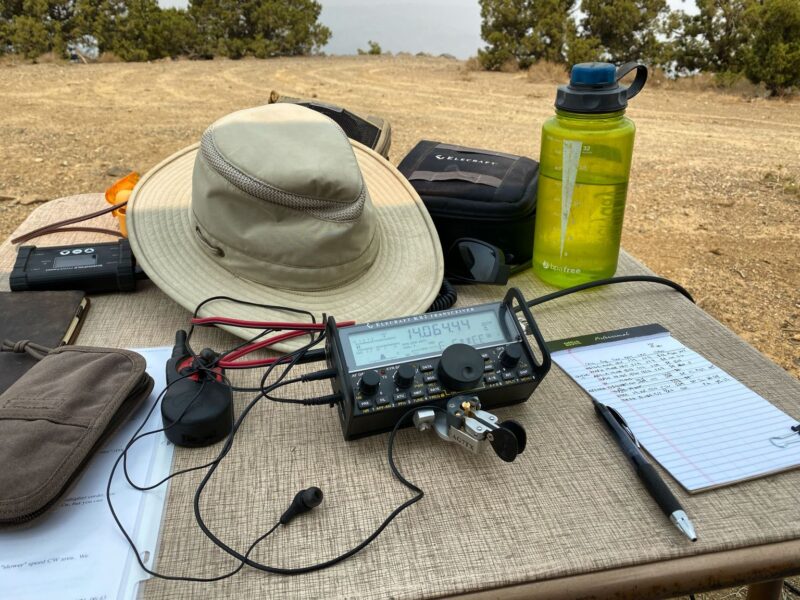
The NJQRP Club hosts an annual event for low-power (QRP) radio amateurs. The event lasts four hours and the objective is to make as many contacts with other low-power operators as possible.
QRP generally means five watts or less for CW Mode (Morse Code) operators and 10w or less for voice (phone) operators. Operations can be home or portable.
With only a few watts to work with, signals can be very weak and operating in a low noise environment with a good antenna becomes important to making contacts. Because of the noise at my home, I usually operate portable. I have some favorite places to set up my portable station and play radio.
This morning I woke about my normal time, rose, made a cup of coffee, and working through my morning routine. I decided to get out and walk Sera, then go up in the Pinion Hills and set up a station and play a little.
It was smoky this morning, but not as bad as it has been. The day promised to be smoky and hot, with afternoon temperatures near 100F. We got in a good walk and then headed for the operating point just after 0930h local.
On the way, I decided to deploy my kit-built EFHW in an inverted “L” configuration using a 10m telescopic mast. I found a anchor point for the mast (an old juniper tree that was cut off at about 4ft. I ran the wire from the wire winder along the mast, tied it off near the top of the mast, and then lashed the mast (and vertical portion of the wire) to the juniper. I tied a bit of cordage to the end of the wire and used that to tie off on another juniper, forming the leg of the inverted “L.”
This is a good antenna and is reasonably tuned to resonate on 10m, 15m, 20m, and 40m. The 30m band was not in the band plan for the event, so there was no loss not having access to the 30m band.
I deployed my Elecraft KX2 with power from a 4.5Ah Bioenno LFP battery and a PowerFilm foldable solar panel. (I was not sure of the state of charge of the battery.) Given I was going to run only 5w, I knew that power usage would be minimal. My station was set up in the shade of the open hatch of my 4Runner.
Doggo was tired and hot, so she laid in the dust out of the sun. I moved an old furniture blanket to give her some relief from the dust. I also retrieved water and her bowl from the rig and both of us got a drink.
I was about an hour late getting started. I am not a serious contester anyway. I just like to play some radio. I started by searching for a few SOTA (Summits on the Air) activators, but quickly noticed two things: First, some kind of contest was ongoing and there were a lot of stations on the air. Second, I heard a couple of stations calling “CQ BZZ” and that meant I could hear Skeeters!
So I abandoned the SOTA chase and focused on the skeeters! I had not prepared a digital log, so paper would have to do. I worked the runners steadily, looking for the loudest first since they were easier to copy. The operators were patient with me as my code skills are still developing. I noticed that a few operators were running slowly, so I added some space between characters to give them a chance to copy my callsign and information. Good operators accommodate slower operators. It is the right thing to do.
Over the course of the next three hours, I logged a dozen contacts. The farthest was in Florida, which is not bad for five watts. I spent most of my time on the 20m band as that is where I heard them. I checked 40m and 15m, but heard no skeeters calling.
Tired, hot, and hungry, I shut down about 1350h local. There was only another ten minutes and I was ready to be out of the heat. So was The Girl.
I took my time packing the station, gave The Girl some more water and drank some myself. The smoke had worsened as the day wore on.
I put the transfer case in 4L and we eased back down the trail to the pavement. Then I switched back to AWD and we drove over to DQ for a bite and a treat. Of course, I ate dessert first (love me some Blizzard) and shared with The Girl. (I always share with her.) Then I nibbled at some chicken strips and shared those with her as well.
It was a good day, despite the heat and smoke. Some of the contacts were difficult, requiring multiple repeats. The signal would fade into the noise and I could only copy part of the exchange. But we worked the radio waves and made the exchange.
One operator called me over the runner’s frequency just as I finished working the station. I thought “how rude!” (oh my, that sounded like Jar Jar Binks!) and did not answer the call. I am not quite sure how I should have handled that call. Perhaps I should have sent “up one” and changed the frequency. I do not know but will ask one of my more experienced operator friends.
In all, I made 12 contacts in 10 different states/provinces. The KX2 performed. I practiced my code. I had fun, even if some of the exchanges were a challenge. I think that is part of the fun or radio and QRP (low power).